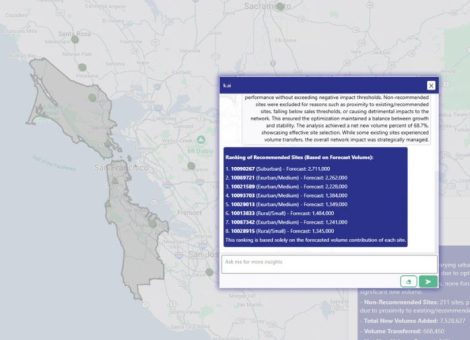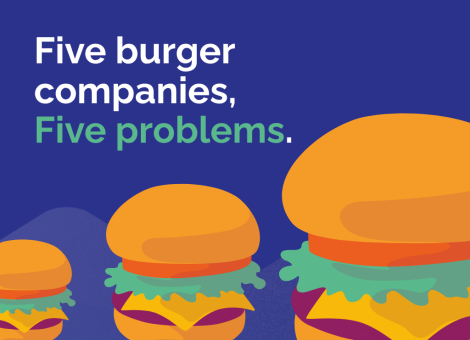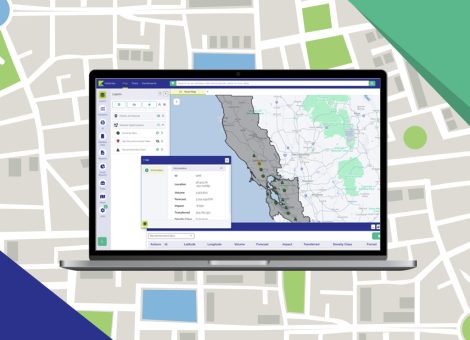Kalibrate deep dive - analytics, the customer experience, and AI: Justin Tischler, Chief Operating Officer

How has the analytics function at Kalibrate evolved in the last 12 months?
One of the most exciting developments has been the evolution of our location intelligence forecasting methodology. Kalibrate has a decades-long heritage as a leader in site selection and market optimization solutions, and our teams have been working to leverage that library of techniques to provide immediate value to customers – admittedly mostly behind the scenes. The net result of this work is that these models are now even better suited to applications across industries and at every stage in a brand’s growth and expansion.
Alongside this advancement of methodology, our data science and product teams have been implementing many of these capabilities in our platforms – you’ll see this in some of the predictive functionality in Competitive Insights, and soon we’ll be able to share some of what we have planned for Kalibrate Pricing. And, we have also been busy expanding our network of data partners to make available a wider array of core and specialty datasets globally for seamless use in Kalibrate Location Intelligence.
Can you tell us about the experience of integrating the teams from Intalytics, eSite, and Trade Area Systems under the Kalibrate umbrella?
One of the things that has been apparent to me all along has been that we really have passionate people across all the teams here – seen both in those who come in with one of the group businesses, as well as in those who have joined more recently. It is great to work alongside people who are so focused and driven, and who take pride in building solutions of the highest quality.
Reflecting specifically on the way each of those companies supported their customers – some with a focus on the software platform with quality data, some with a more consultancy-led approach to solving business problems, or commonly a mix – bringing those slightly different perspectives together has made our new team better equipped to help our customers make better decisions today.
Our Client Advisory Board flagged customer experience as a priority. How is that considered by the analytics team?
We want the focus on our customers’ experience to be a top priority for all teams at Kalibrate. From an analytics and consulting lens, part of this is realized in our aim to meet our clients where they are and how they want to be supported – which means taking into account their rate of growth and change, the quality and availability of relevant data, and where their internal teams most want support. We serve a very diverse group of clients across industries, scale, and geography, with a variety of business models – so this process is crucial when we’re delivering a comprehensive solution that includes predictive analytics.
For the analytics function, meeting our clients in this way could mean matching a model’s frequency update to the brand’s requirements. Some brands want results from the forecasting model to be relatively stable over some period of time (for example, a fiscal year), while other brands place a higher value on having hyper-recent data driving the model. This could also mean being mindful of how much of the model we expose. We don’t build black box solutions – we are more than happy to work with customers who want to see all details of the model at every step along the way, with full visibility in our platform. But many times, our customers tell us in essence “You are the expert. We’ll focus on other priorities, Kalibrate can tell us what this location should do.” Our analytics and consulting teams have the depth and breadth of experience to be flexible in accommodating these and other nuances in how we engage: adding support or model visibility as needed, or bringing our expertise to gap-fill their resources as requirements change.
The arrival of ChatGPT and other platforms has put AI in the hands of thousands of business users. How do you see these platforms impacting retailers – and those, like you, working in analytics?
The growth in adoption of AI in the last year has been incredible. We clearly are all seeing many of the business-oriented solutions leaning in a “copilot” angle, meaning that rather than trusting the output of the LLM [large language model] without vetting, to instead think of the tool as a force multiplier or jumping off point for the human side of the work. For example, retail decision-makers needing to undertake investigative work leveraging data on the public internet – such as synthesizing market sentiment about their brand as interpreted by LLMs with web access – will start with that query, but naturally build on the results, or use it as one data point among many. And our analysts and consulting teams are already using AI tools to help us cover foundational research in new ways and at speeds that were not possible before.
But, as with many similar models, one challenge is understanding the factors that drive a given prediction. In this case, the AI is predicting which words and phrases and paragraphs should go together as a proper reaction to the input prompt (and possibly to other prior “predictions”). But understanding why any given answer was given is challenging – these tools are black boxes with proprietary human-overlaid guardrails. While the outputs can sound very convincing, the factual accuracy can be far off the mark or even “hallucinatory”, and this is when it’s most important to ask the question “why?”.
Balancing the value of a digital copilot, which absolutely will accelerate decision-making and efficiency, against the challenges of reliability and accountability, will put to test an organization’s policies and processes. And further, with the rapid advancement of the quality and availability of these tools, I expect we’ll see a continued response from owners of original content away from allowing en masse unpaid use in model training.
Is there anything you would like to leave customers with?
Beyond what I mentioned about our modeling methodology advancement, we have been working to evolve and improve the way users interact with these models in KLI. If you use predictive analytics in KLI, we’re excited to get this in your hands, and look for us to share more on this in the coming months.
As ever, if there’s a business question you’ve been looking to answer but unsure where to start, reach out to your account contact. We’re always happy to do some investigations into what can be achieved through our solution set.
Read more articles about:
Location intelligenceSubscribe and get the latest updates
You may unsubscribe from our mailing list at any time. To understand how and why we process your data, please see our Privacy & Cookies Policy
Related resources
Location intelligence
AI in location intelligence: The force multiplier for smarter site selection
AI is rapidly advancing in the world of real estate - this is the first blog in a two-part series on incorporating AI...

Location intelligence
Five burger companies, five problems
These burger brands had challenges from international growth to understanding franchise locations cannibalization,...


